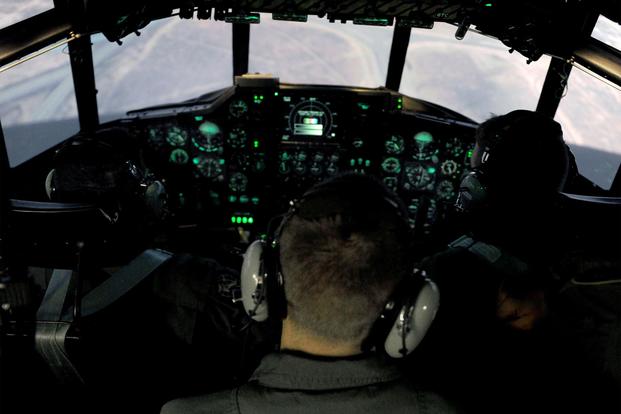ABOARD A C-37 MILITARY AIRCRAFT -- Take off. Fly. Practice. Land. Repeat. And repeat and repeat -- all without going outside. It's what more pilots are likely to see as the Air Force weighs how to expand simulation training time across its ranks, according to the service's outgoing top civilian.
The Air Force awaits the latest results from the second iteration of its Pilot Training Next (PTN) Program, hosted by Air Education and Training Command (AETC) in Austin, Texas. The findings are due to Air Force Secretary Heather Wilson's successor in the next few weeks. On Wednesday, Acting Defense Secretary Patrick Shanahan named Air Force Under Secretary Matt Donovan, a former F-15C Eagle pilot, to become the acting secretary June 1, following Wilson's departure.
But Wilson said that more simulator time should be a "no-brainer" for pilots to become proficient in basic skills before they get inside a real cockpit.
PTN is "an example of, we didn't just change pilot training, we said, 'Let's do an experiment, and what are we learning from that?' One of the things we've learned, no matter what else we do, is that we need to put simulators into the dorms 24/7 for pilot training. That's a no-brainer because it accelerates learning," she said during an exclusive interview with Military.com on Tuesday.
Related content:
- Inside the Air Force's Plan to Revolutionize Pilot Training
- F-15X and GenZ: Former Air Combat Command Chief on the Future Air Force
- SecAF Wilson: Mattis' Departure Made it Easier for Me to Resign
Military.com traveled with the outgoing secretary on one of her last trips to Air University at Maxwell Air Force Base, Alabama, before she departs the Pentagon in the next two weeks to take her new position as president of the University of Texas at El Paso.
Wilson's assessment comes after Gen. Mike Holmes, head of Air Combat Command, and AETC commander Lt. Gen. Steven Kwast voiced similar positions on the imperative to create a more diverse pilot training experience.
Learning through augmented reality boosts initial competence, "because they're getting more repetitions," Wilson said.
The Air Force will "take a look at what the results of that experience are, and how those pilots do when they go on. It's not entirely virtual reality. It is that, combined with the jet training," she said.
"There's a rule in flight training ... that the cockpit is a lousy classroom. Because you can't pause what you're doing to say, 'Wait a minute that didn't work, what did I just do wrong?' Because you're onto the next thing," Wilson said. "You always have to be ahead of the airplane. So it's a lousy classroom. So if we can create a classroom where we can pause, but gives you the fidelity of virtual reality, that's great. I think we're actually going to move more toward that."
Virtual reality training could benefit other career fields besides pilots, she said, especially maintainers who repair some of the most complex aircraft across the service.
"A quarter of our enlisted force are maintenance. And it's some of the most complicated work we do. But we're not taking advantage of technology to teach," Wilson said.
Too Selective in Picking Pilots?
Virtual reality training is part of a larger discussion on the service's ongoing pilot shortage.
In written testimony before the Senate Armed Services subcommittee on personnel in February, Lt. Gen. Brian Kelly, deputy chief of staff for manpower, personnel and services, said that the Air Force ended fiscal 2018 with a total force pilot shortage of 1,937. The service said it was roughly 2,000 pilots short in 2017.
Following Military.com's story this month about the service's plan to revolutionize pilot training by using more virtual and digital means, some readers voiced concerns that the Air Force is turning prospective pilots away without a good reason, thus leading to a gap in aviation personnel.
Wilson said it's not that simple. "We've had plenty of people volunteer to be pilots in the Air Force. Our problem is not at the front end to get people into training. We're still very selective," she said Tuesday. "[Most rejections] are medical, or eyesight or those kinds of things. The key was, we needed to increase the number of pilot training slots."
Last year, retired Gen. Herbert "Hawk" Carlisle, former ACC commander, said training slots are a big issue.
"We have to experience them and retain them. We drew down tons of airplanes in the Air Force -- too many," he said last summer. "And now trying to go back up, we don't have the cockpits to experience people. We don't have the cockpits to bring in more young guys and, at the same time, for the retaining [portion], we are burning them out because the deployment schedules are horrendous."
Fixing the pilot shortage will require better retention practices, as well as increased selections, Wilson said.
"We can't solve this with retention alone, so we've increased over the last two years and we'll increase again next year, the number of people going through pilot training with an objective to get to about 1,500 a year," she said. "We [still] need to train more pilots."
-- Oriana Pawlyk can be reached at oriana.pawlyk@military.com. Follow her on Twitter at @Oriana0214.












